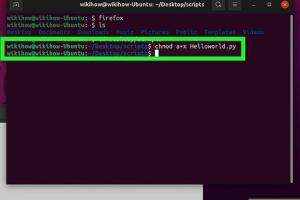Mastering the Command Line: A Comprehensive Guide to Running Programs on Linux

-
Quick Links:
- 1. Introduction
- 2. Understanding the Command Line Interface
- 3. How to Run a Program from the Command Line
- 4. Common Commands for Running Programs
- 5. Case Studies and Examples
- 6. Troubleshooting Common Issues
- 7. Advanced Techniques for Power Users
- 8. Conclusion
- 9. FAQs
1. Introduction
The Linux command line is a powerful tool that allows users to perform various tasks by typing commands. Unlike graphical user interfaces (GUIs), the command line provides a more efficient way to interact with the operating system. In this guide, we'll explore how to run programs from the command line on Linux, catering to both beginners and experienced users.
2. Understanding the Command Line Interface
Before diving into running programs, it's essential to understand what the command line interface (CLI) is. The CLI allows users to communicate with the operating system through text-based commands. Below are some key components:
- Shell: The shell interprets the commands entered and executes them. Popular shells include Bash, Zsh, and Fish.
- Terminal: The terminal is the application that opens a CLI window, allowing users to interact with the shell.
- Command Syntax: Commands generally follow a syntax that includes the command itself, options (flags), and arguments (files/directories).
3. How to Run a Program from the Command Line
Running a program from the command line can vary depending on the program and the desired outcome. Here’s a step-by-step guide:
3.1 Basic Command Structure
The general syntax to run a program is:
program_name [options] [arguments]For example, to run the text editor Nano, you would type:
nano filename.txt3.2 Navigating Directories
Before executing a program, you may need to navigate to its directory. Use the following commands:
- cd: Change directory. Example:
cd /path/to/directory - ls: List files in a directory. Example:
ls -l
3.3 Running Executable Files
To run an executable file, you might need to prepend it with `./` if it's in the current directory. For example:
./my_executable4. Common Commands for Running Programs
Here are some common commands you'll frequently use when running programs from the command line:
- open: Open files with their default application. Example:
open file.pdf - chmod: Change file permissions. Example:
chmod +x my_script.sh - nohup: Run commands that ignore hangup signals. Example:
nohup my_script.sh &
5. Case Studies and Examples
Let’s explore a few case studies that highlight how running programs from the command line can streamline workflow:
5.1 Case Study: Automating Backups
Using the command line, users can automate backup processes with scripts. For instance, a simple bash script can copy files to a backup directory. Here’s an example:
#!/bin/bash
cp -r /home/user/data /home/user/backup/data_$(date +%Y%m%d)5.2 Case Study: Batch Processing Images
Running a command-line image processing tool like ImageMagick can allow bulk image conversions:
mogrify -resize 800x800 *.jpg6. Troubleshooting Common Issues
Even experienced users face issues while running programs. Here are common problems and solutions:
6.1 Command Not Found
If you encounter a “command not found” error, ensure the program is installed and in your PATH:
echo $PATH6.2 Permission Denied
If you face permission issues, you might need to change permissions or run the command as a superuser:
sudo ./my_script.sh7. Advanced Techniques for Power Users
For advanced users, leveraging command-line features can enhance productivity:
7.1 Piping and Redirection
Piping allows you to pass the output of one command as input to another:
cat file.txt | grep "search_term"7.2 Using Aliases
Creating aliases for frequently used commands can save time:
alias gs='git status'8. Conclusion
Running programs from the command line on Linux is a valuable skill that enhances your ability to interact with the system efficiently. Whether you're automating tasks, troubleshooting issues, or optimizing workflows, mastering the command line can significantly boost your productivity.
9. FAQs
1. What is a command line in Linux?
The command line is a text-based interface used to interact with the operating system by entering commands.
2. How do I open the command line on Linux?
You can open the terminal application from your system's application menu or by pressing Ctrl + Alt + T.
3. What is the difference between a terminal and a shell?
The terminal is the interface, while the shell is the program that interprets your commands.
4. Can I run GUI applications from the command line?
Yes, most GUI applications can be launched from the command line by typing their executable name.
5. What should I do if a command fails?
Check for typos, ensure the program is installed, or consult the command’s manual using man command_name.
6. How can I see a list of all available commands?
Type compgen -c in the terminal to see a list of all available commands.
7. What are environment variables?
Environment variables are dynamic values that affect the processes running on your computer.
8. How do I run background processes?
You can run a process in the background by appending an ampersand (&) to the command.
9. What is the purpose of the sudo command?
The sudo command allows users to run commands with superuser privileges.
10. Can I schedule commands to run automatically?
Yes, you can use cron jobs to schedule commands to run at specific intervals.
Random Reads
- How to check earthing at home
- How to check identify ipod generation
- 10 ways to fix facebook crashing
- 10 tips to drill through metal
- Transform bathroom into sauna
- How to add documents in gmail
- How to add drop down box excel 2007
- How to restart pokemon platinum
- How to find an ip address
- How to find and make gaming friends